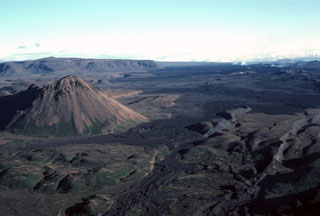Report on Krafla (Iceland) — May 1979
Scientific Event Alert Network Bulletin, vol. 4, no. 5 (May 1979)
Managing Editor: David Squires.
Krafla (Iceland) New deflation event; 1.5 m of rifting N of the calder
Please cite this report as:
Global Volcanism Program, 1979. Report on Krafla (Iceland) (Squires, D., ed.). Scientific Event Alert Network Bulletin, 4:5. Smithsonian Institution. https://doi.org/10.5479/si.GVP.SEAN197905-373080
Krafla
Iceland
65.715°N, 16.728°W; summit elev. 800 m
All times are local (unless otherwise noted)
"Deflation of Krafla took place 13-18 May. The main features are similar to the previous deflation event. Before this deflation, the volcano had inflated for two months beyond previous maximum levels and a deflation event had been anticipated since March. Earthquake activity above the magma reservoirs increased significantly during this time. This earthquake activity stopped with the first sign of deflation during the early hours of 13 May. The deflation rate increased only gradually, reaching a maximum (~5 µrad/hour at the Krafla powerhouse) during the afternoon of 14 May.
"Small earthquakes occurred N of the volcano and the epicenters moved northward along the fault swarm. The seismic activity increased markedly on 14 May, shortly before midnight. The earthquakes were associated with extensive rifting in the fault swarm 10-20 km N of Krafla. Geodimeter lines in this part of the fault swarm extended up to 1.5 m during the event. Some of those lines have now extended 3.5 m in less than 1 year, in three rifting events.
"Total subsidence of the center of the deflation is estimated at 70-80 cm, corresponding to about 40 x 106 m3 of removed magma. Inflation started again at about 1600 on 18 May and continues. Land elevation is expected to reach the previous maximum in 4-5 months."
Geological Summary. The Krafla volcanic system in the Northern Volcanic Zone (NVZ) of Iceland is about 100 km long, consisting of a fissure swarm and a central volcano with a 7 x 9 km caldera formed about 110,000 years ago that deposited a rhyolitic welded tuff. It has been moderately active in the Holocene, over three distinct eruptive periods; the current one has lasted about 2,800 years with six volcano-tectonic episodes, each with one or more basaltic fissure eruptions. Lava volumes (DRE) have been in the 0.1-1 km3 range. The Hverfjall and Ludent tuff rings east of Myvatn were erupted along the fissure system. Myvatn lake formed during the eruption of the older Laxarhraun lava flow from the Ketildyngja shield volcano of the Fremrinamur volcanic system about 3,800 years before present (BP); The present Myvatn lake is constrained by the roughly 2,000 years BP younger Laxarhraun lava flow from the Krafla volcanic system. The abundant pseudocraters that form a prominent part of the Myvatn landscape were created when the younger Laxarhraun lava flow entered the lake. The last eruption took place in 1975-1984 CE when nine small basaltic fissure eruptions produced 0.25 km3 of lava.
Information Contacts: K. Grönvold, NVI; P. Einarsson, Univ. of Iceland.

